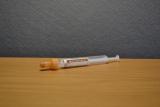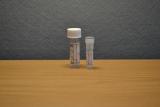Test Directory
Hyaluronic acid
Containers - Adult

Brown Cap, Gel Clotted
|
Volume Range
1 mL
Additive per Container
None |
Containers - Child

White Capped Clotted Blood Tube
|
Volume Range
1 mL
Additive per Container
None |
Laboratory Site
Old Dalkeith Road
Edinburgh
EH16 4SA
Availability
Test only available to the following specialties: GI, dermatology and rheumatology
Anticipated turnaround
7 days
General additional information
Background
Hyaluronic acid (HA) is an unbranched glycosaminoglycan, produced mainly in mesenchymal cells and is widely distributed in connective tissue throughout the body.1,2 Liver is an significant source of HA. It has several physiological functions, e.g. lubrication in joints, prevention from bacterial invasion and internal body hydration. In patients with developing fibrotic liver disease, serum levels of HA increase. Serum concentration of HA is consistent with stage of fibrosis, and also decreases with a response to interferon therapy in patients with HCV chronic infection.3‑9 It therefore has very useful clinical utility as a non-invasive marker to exclude cirrhosis. 10 HA has been available in Lothian for many years. Testing was originally carried out by the Hepatology laboratory at the University of Edinburgh, before the service transferred in 2019 to NHS Lothian Department of Clinical Biochemistry. The service is available to gastroenterology, dermatology and rheumatology with cross charging arrangements in place.
Laboratory Clinical Interpretation
In NHS Lothian a reference range of <60 ng/mL is used. At this cut-off concentration of 60 ng/mL, HA typically shows a negative predictive value of up to 100% and a positive predictive value of 61% for cirrhosis.11, 12 In practice, values over 100 ng/mL are suggestive of cirrhosis however values normally exceed this. In contrast, values less than 60 ng/mL are very reassuring, especially if combined with a normal Fibroscan and FIB4 score. The lower analytical limit of the assay has been revised to 50 ng/mL from August 2021 due to inadequate performance below this level. This means a result of less than 50 will now appear on reports as “<50 ng/mL” and is unlikely to be clinical significant.
Serum HA concentrations in patients with conditions such as rheumatoid arthritis, osteoarthritis and systemic lupus erythematosis need to be interpreted with the knowledge that these conditions may also cause elevated results.11 Values of 50-100 ng/mL are common in the elderly and most likely reflect joint damage.
How often is monitoring hyaluronic acid required?
Colleagues in Hepatology (NHS Lothian) suggest monitoring more frequently than once every 2 years is unlikely to be helpful in most cases. Repeat requests within 18 months will no longer be processed (unless it is to confirm a new result >60 ng/mL).
Indications for Fibroscan and hepatology referral
For individuals with a newly elevated hyaluronic acid (i.e. >60 ng/mL), suggest repeat and if >60ng/mL on repeat specimen, refer for Fibroscan.
For individuals with a new finding of hyaluronic acid >100 ng/mL, suggest repeat and if >100ng/mL on repeat specimen, refer for Fibroscan and a hepatology referral.
References
1. Stryer T., et al.: Biochemistry (Third Edition). 1988; 275-277.
2. Laurent T.C., et al.: Ciba foundation Symposium. 1986; 124: 9–29.
3. Oberti F., et al.: Gastroenterology. 1997; 113(5): 1609-1616.
4. Plevris J.N., et al.: Eur J Gastroenterol Hepatol. 2000; 12(10): 1121-1127.
5. Guéchot J., et al.: J Hepatol. 1995; 22 (2 Suppl): 103-106.
6. Pares A., et al.: Hepatology. 1996; 24 (6): 1399-1403.
7. Yamada M., et al.: J Gastroenterol Hepatol. 1996; 11(7): 646-651.
8. Sandra J., et al.: Hepatology. 2004; 40 (4): 1200, 687A.
9. Suzuki A., et al.: Liver Int. 2005; 25 (4): 779-786.
10. Gudowska M., et al.: Acta Biochim Pol. 2017; 64(3): 451-457.
11. Frébourg T. et al.: Hepatology. 1986; 6(3):392-395.
12. Majid M. et al.: Ann Rheum Dis. 2004; 63: 1166-1168.